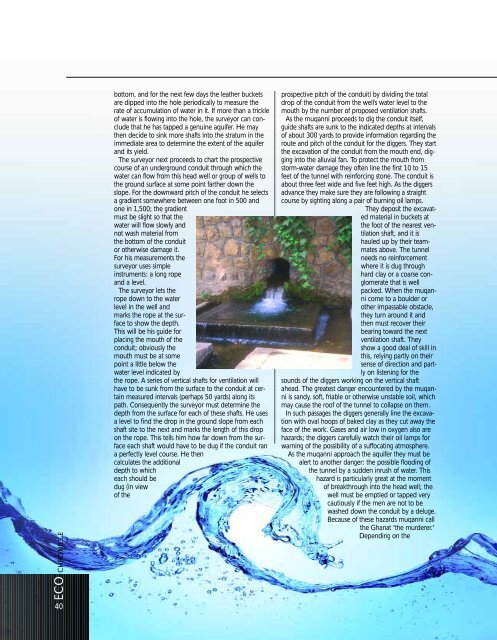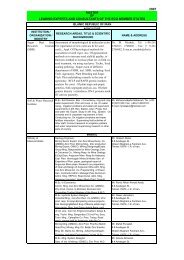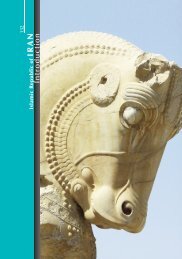ECO-IEST President, Alternative Member to the IPBES Bureau
ECO-IEST President, Alternative Member to the IPBES Bureau
ECO-IEST President, Alternative Member to the IPBES Bureau
Create successful ePaper yourself
Turn your PDF publications into a flip-book with our unique Google optimized e-Paper software.
<strong>ECO</strong> CHRONICLE<br />
40<br />
bot<strong>to</strong>m, and for <strong>the</strong> next few days <strong>the</strong> lea<strong>the</strong>r buckets<br />
are dipped in<strong>to</strong> <strong>the</strong> hole periodically <strong>to</strong> measure <strong>the</strong><br />
rate of accumulation of water in it. If more than a trickle<br />
of water is flowing in<strong>to</strong> <strong>the</strong> hole, <strong>the</strong> surveyor can conclude<br />
that he has tapped a genuine aquifer. He may<br />
<strong>the</strong>n decide <strong>to</strong> sink more shafts in<strong>to</strong> <strong>the</strong> stratum in <strong>the</strong><br />
immediate area <strong>to</strong> determine <strong>the</strong> extent of <strong>the</strong> aquifer<br />
and its yield.<br />
The surveyor next proceeds <strong>to</strong> chart <strong>the</strong> prospective<br />
course of an underground conduit through which <strong>the</strong><br />
water can flow from this head well or group of wells <strong>to</strong><br />
<strong>the</strong> ground surface at some point far<strong>the</strong>r down <strong>the</strong><br />
slope. For <strong>the</strong> downward pitch of <strong>the</strong> conduit he selects<br />
a gradient somewhere between one foot in 500 and<br />
one in 1,500; <strong>the</strong> gradient<br />
must be slight so that <strong>the</strong><br />
water will flow slowly and<br />
not wash material from<br />
<strong>the</strong> bot<strong>to</strong>m of <strong>the</strong> conduit<br />
or o<strong>the</strong>rwise damage it.<br />
For his measurements <strong>the</strong><br />
surveyor uses simple<br />
instruments: a long rope<br />
and a level.<br />
The surveyor lets <strong>the</strong><br />
rope down <strong>to</strong> <strong>the</strong> water<br />
level in <strong>the</strong> well and<br />
marks <strong>the</strong> rope at <strong>the</strong> surface<br />
<strong>to</strong> show <strong>the</strong> depth.<br />
This will be his guide for<br />
placing <strong>the</strong> mouth of <strong>the</strong><br />
conduit; obviously <strong>the</strong><br />
mouth must be at some<br />
point a little below <strong>the</strong><br />
water level indicated by<br />
<strong>the</strong> rope. A series of vertical shafts for ventilation will<br />
have <strong>to</strong> be sunk from <strong>the</strong> surface <strong>to</strong> <strong>the</strong> conduit at certain<br />
measured intervals (perhaps 50 yards) along its<br />
path. Consequently <strong>the</strong> surveyor must determine <strong>the</strong><br />
depth from <strong>the</strong> surface for each of <strong>the</strong>se shafts. He uses<br />
a level <strong>to</strong> find <strong>the</strong> drop in <strong>the</strong> ground slope from each<br />
shaft site <strong>to</strong> <strong>the</strong> next and marks <strong>the</strong> length of this drop<br />
on <strong>the</strong> rope. This tells him how far down from <strong>the</strong> surface<br />
each shaft would have <strong>to</strong> be dug if <strong>the</strong> conduit ran<br />
a perfectly level course. He <strong>the</strong>n<br />
calculates <strong>the</strong> additional<br />
depth <strong>to</strong> which<br />
each should be<br />
dug (in view<br />
of <strong>the</strong><br />
prospective pitch of <strong>the</strong> conduit) by dividing <strong>the</strong> <strong>to</strong>tal<br />
drop of <strong>the</strong> conduit from <strong>the</strong> well's water level <strong>to</strong> <strong>the</strong><br />
mouth by <strong>the</strong> number of proposed ventilation shafts.<br />
As <strong>the</strong> muqanni proceeds <strong>to</strong> dig <strong>the</strong> conduit itself,<br />
guide shafts are sunk <strong>to</strong> <strong>the</strong> indicated depths at intervals<br />
of about 300 yards <strong>to</strong> provide information regarding <strong>the</strong><br />
route and pitch of <strong>the</strong> conduit for <strong>the</strong> diggers. They start<br />
<strong>the</strong> excavation of <strong>the</strong> conduit from <strong>the</strong> mouth end, digging<br />
in<strong>to</strong> <strong>the</strong> alluvial fan. To protect <strong>the</strong> mouth from<br />
s<strong>to</strong>rm-water damage <strong>the</strong>y often line <strong>the</strong> first 10 <strong>to</strong> 15<br />
feet of <strong>the</strong> tunnel with reinforcing s<strong>to</strong>ne. The conduit is<br />
about three feet wide and five feet high. As <strong>the</strong> diggers<br />
advance <strong>the</strong>y make sure <strong>the</strong>y are following a straight<br />
course by sighting along a pair of burning oil lamps.<br />
They deposit <strong>the</strong> excavated<br />
material in buckets at<br />
<strong>the</strong> foot of <strong>the</strong> nearest ventilation<br />
shaft, and it is<br />
hauled up by <strong>the</strong>ir teammates<br />
above. The tunnel<br />
needs no reinforcement<br />
where it is dug through<br />
hard clay or a coarse conglomerate<br />
that is well<br />
packed. When <strong>the</strong> muqanni<br />
come <strong>to</strong> a boulder or<br />
o<strong>the</strong>r impassable obstacle,<br />
<strong>the</strong>y turn around it and<br />
<strong>the</strong>n must recover <strong>the</strong>ir<br />
bearing <strong>to</strong>ward <strong>the</strong> next<br />
ventilation shaft. They<br />
show a good deal of skill in<br />
this, relying partly on <strong>the</strong>ir<br />
sense of direction and partly<br />
on listening for <strong>the</strong><br />
sounds of <strong>the</strong> diggers working on <strong>the</strong> vertical shaft<br />
ahead. The greatest danger encountered by <strong>the</strong> muqanni<br />
is sandy, soft, friable or o<strong>the</strong>rwise unstable soil, which<br />
may cause <strong>the</strong> roof of <strong>the</strong> tunnel <strong>to</strong> collapse on <strong>the</strong>m.<br />
In such passages <strong>the</strong> diggers generally line <strong>the</strong> excavation<br />
with oval hoops of baked clay as <strong>the</strong>y cut away <strong>the</strong><br />
face of <strong>the</strong> work. Gases and air low in oxygen also are<br />
hazards; <strong>the</strong> diggers carefully watch <strong>the</strong>ir oil lamps for<br />
warning of <strong>the</strong> possibility of a suffocating atmosphere.<br />
As <strong>the</strong> muqanni approach <strong>the</strong> aquifer <strong>the</strong>y must be<br />
alert <strong>to</strong> ano<strong>the</strong>r danger: <strong>the</strong> possible flooding of<br />
<strong>the</strong> tunnel by a sudden inrush of water. This<br />
hazard is particularly great at <strong>the</strong> moment<br />
of breakthrough in<strong>to</strong> <strong>the</strong> head well; <strong>the</strong><br />
well must be emptied or tapped very<br />
cautiously if <strong>the</strong> men are not <strong>to</strong> be<br />
washed down <strong>the</strong> conduit by a deluge.<br />
Because of <strong>the</strong>se hazards muqanni call<br />
<strong>the</strong> Ghanat "<strong>the</strong> murderer."<br />
Depending on <strong>the</strong>















